
嘉木扬•图布丹大师在各地弘传佛法之与海棠山普安寺的佛缘
Master Jiamuyang Tubutan promotes Buddhism in various places and the Buddhist connection with Pu'an Temple in Haitang Mountain
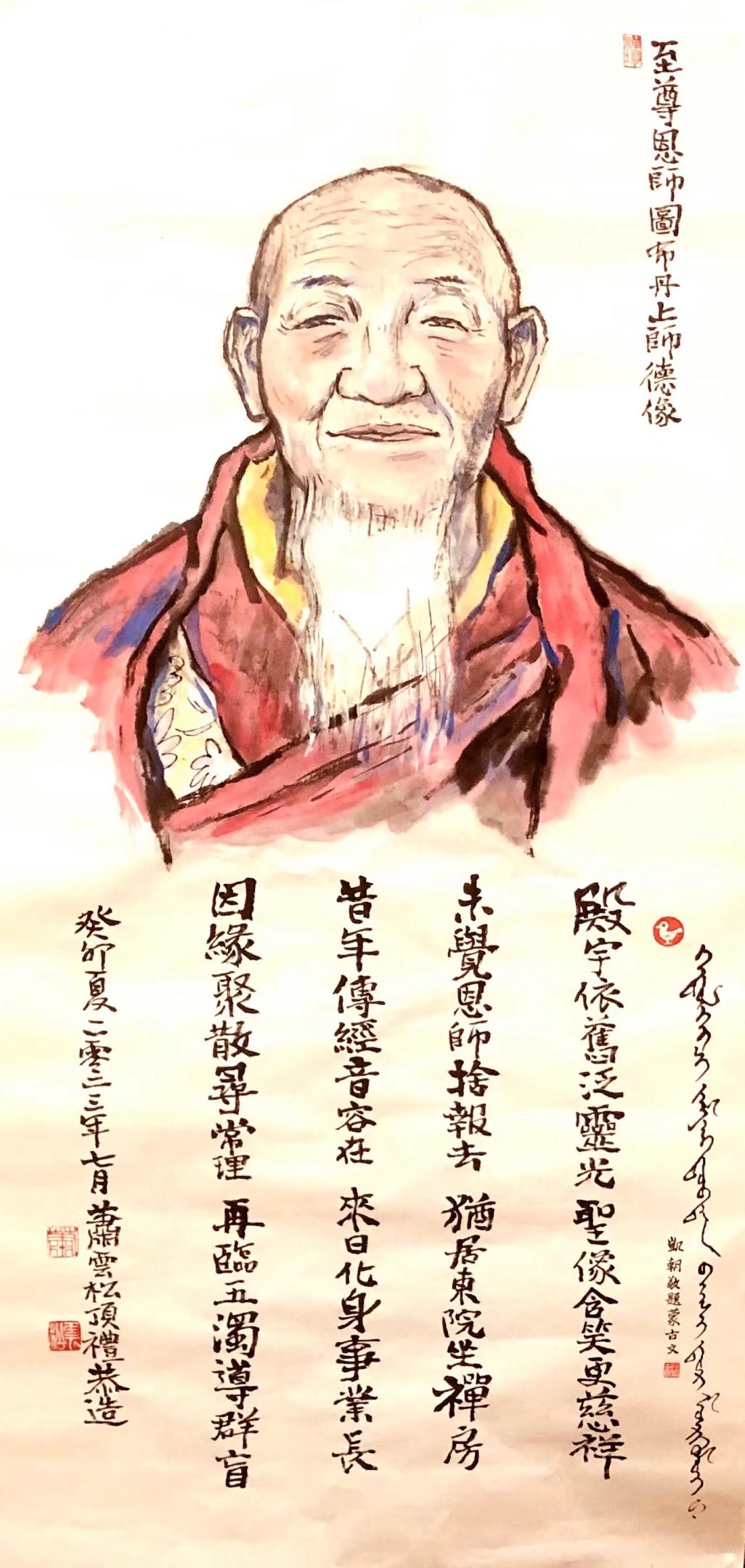
辽宁阜新海棠山普安寺,2006 年 10月3 日至8 日,迎请雍和宫住持嘉木扬•图布丹大师,主持海棠山全山寺院开光和主法“无量寿佛灌顶”;2010年5月20日,主法“观音菩萨灌顶法会”。
From October 3 to 8, 2006, Pu'an Temple of Haitang Mountain in Fuxin, Liaoning Province welcomed Master Jiamuyang Tubutan, the abbot of the Yonghe Temple, to preside over the opening of the all temples of Haitang Mountain and the religious ceremonies "Amitayou Buddha". On May 20, 2010, the ceremony "Guanyin Bodhisattva Summit Dharma Meeting" was held.
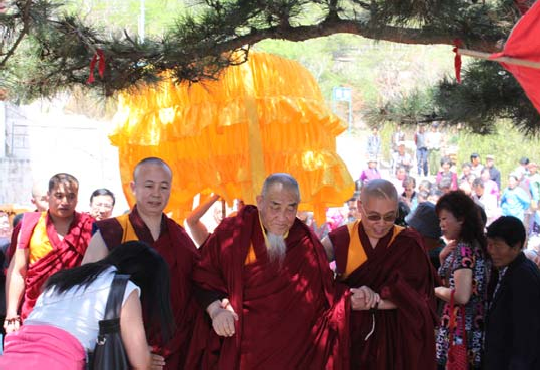
海棠山普安寺迎请嘉木扬·图布丹大师
Haitang Mountain Pu'an Temple welcomes Master Jiamuyang Tubutan
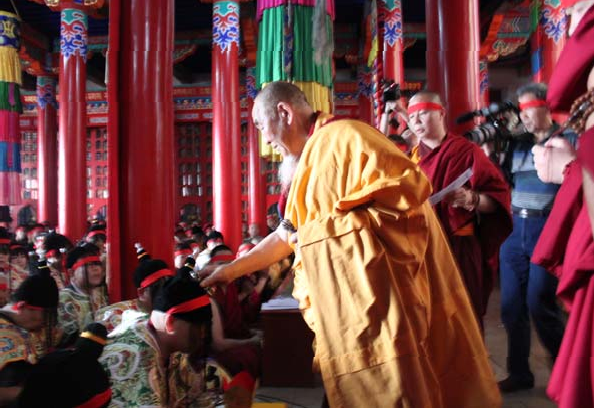
嘉木扬·图布丹大师灌顶加持
Jiamuyang Tubudan Master's Capping Blessing
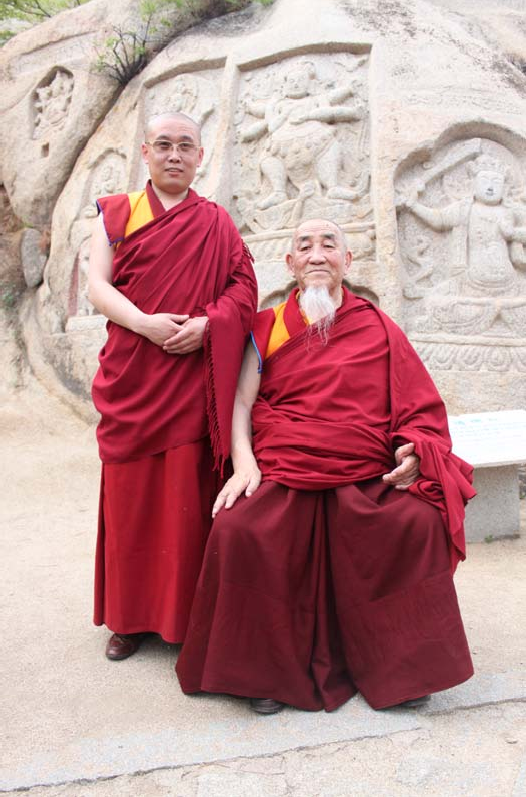
嘉木扬·图布丹大师与海棠山普安寺一希住持
Master Jiamuyang Tubutan and Master Yixi, the abbot of Pu'an Temple in Haitang Mountain
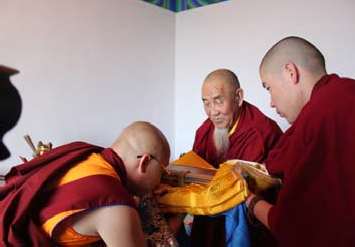
嘉木扬·图布丹大师为海棠山普安寺一希住持赠送经典
Master Jiamuyang Tubutan presented a classic to the abbot of Pu'an Temple in Haitang Mountain
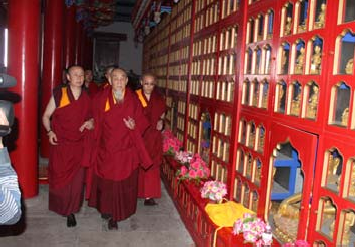
迎请嘉木扬·图布丹大师主法
Welcome to Master Jiamuyang Tubutan to the ceremony
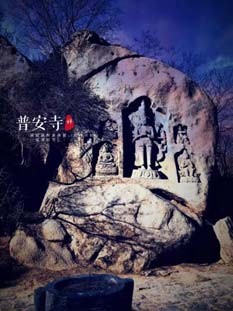
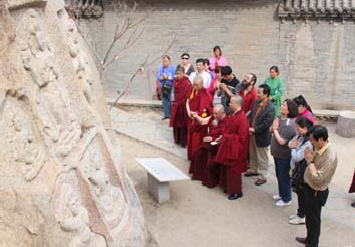
嘉木扬·图布丹大师为海棠山摩崖造像群诵经祈福佛法永住世间利乐有情Master Jiamuyang Tubutan recited sutras and prayed for blessings on the Haitang Mountain Cliff Sculpture Group, wishing the Buddha Dharma a lasting presence and benefit to the world.
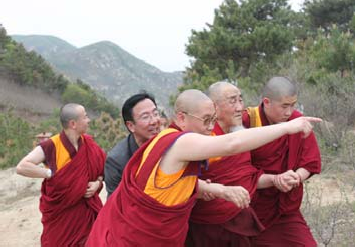
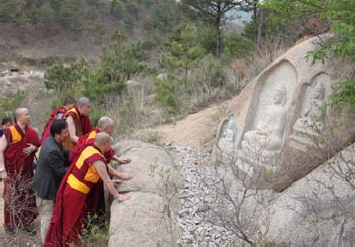
海棠山普安寺一希住持为嘉木扬·图布丹大师介绍摩崖造像群
The abbot of Pu'an Temple in Haitang Mountain, Yixi, introduced the cliff sculpture group to Master Jiamuyang Tubutan

普安寺全景
Panorama of Pu'an Temple
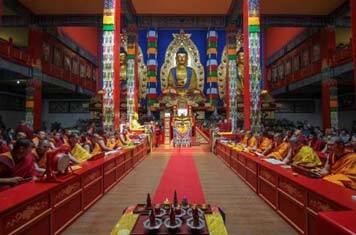
普安寺佛事活动殿堂
Pu'an Temple Buddhist Activity Hall
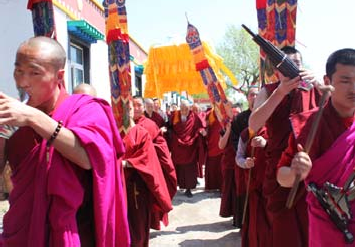
海棠山普安寺迎请嘉木扬·图布丹大师
Haitang Mountain Pu'an Temple welcomes Master Jiamuyang Tubutan
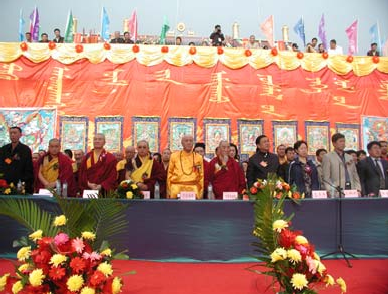
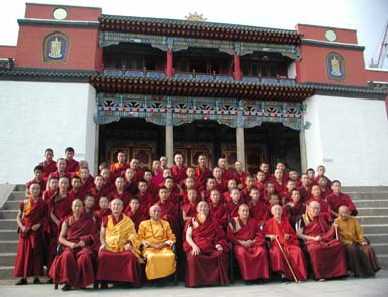
2006 年 10 月嘉木扬·图布丹大师参加海棠山开光大典
In October 2006, Master Jiamuyang Tubutan participated in the Haitang Mountain Blooming Ceremony
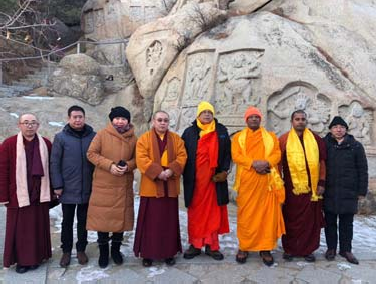
斯里兰卡长老访问海棠山普安寺
Buddhist Elders in Sri Lanka Visiting Pu'an Temple on Mount Haitang
普安寺简介
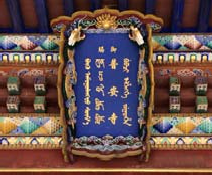
普安寺蒙古语称:阿喇坦锡热图(Altan Xiregetu Sumu),俗称大喇嘛洞,始建于康熙二十二年,坐落于医巫闾山北段正脊海棠山东麓。俯瞰全山,形似蛟龙。哈喇山及萨本山犹如两翼,自东西延伸;暖河状如玉带,从寺前流过。殿宇琼阁,依山傍势,鳞次栉比。发五色之渥彩,
光焰朗以景彰。藏密石窟,摩崖佛像,栩栩如生。体象应乎天地,经纬合乎阴阳。乃千年名刹,普安圣境。世称佛母道场,蒙古佛教东方中心之一。
《全辽志》载:“山以医巫闾为灵秀之最”。“其山掩抱六重,亦谓之六山。” 是我国五大镇山之一。普安寺缘起之说,载于《医巫闾山志》及《阜新县志·卷三仙释》,志曰:“普安寺转世喇嘛也(一世活佛巴雅斯古朗 1632——1694),伊前身系务农,一日耕于野,一猎人尾一白兔至,其匿于犁下,及猎人往,纵之不去,疑求护送之,行至一山洞忽不见,遂有所悟,不复返矣。后其妻访知,往馈食一次,再见虎伏洞口,怯归,疑已死。越二年,忽出现,收六人创修是寺。自言当生某,遂不知所终。逾数年,其徒如言往寻,果得,遂迎为佛,喇嘛(高僧) 自此转相轮回。”普安寺主系活佛法脉传承至今。
清康熙三十年 (公元 1681 年)春,一日,晨曦初照,祥光和煦,年逾半百的巴雅斯古朗,一如往常下地耕田,又兼牧牛于海棠山下。暇时持珠念佛于树荫,见牛人田垅,忙置佛珠驱牛之际,忽遇猎人追一白兔至其前,巴雅斯古朗不加思索将白兔藏于犁下,直待猎人走远。获救的白兔灵性非常,忽衔其珠,有意在前引路,将其引至一山洞口,佛珠复得。巴雅斯古朗不解其意,于是便进洞探个究竞,只见洞内有一位坐化己久的和尚虹身,面前石桌上摆放着数本佛经。巴雅斯古朗翻阅,有参禅修密的经书 《大日经》(楞严经》等及医书、《易经》等。还发现书中夹有一封遗书手稿,上书:“吾乃千山中流山长老也,为避金兵战乱, 至此修道,然道未成,烛火将熄,后人拾到此书者继续修道,必成正果。此山大有兴黄教之时焉。”读完此文的巴雅斯古朗,瞬间似已脱凡人圣,而登妙觉。注目洞中幽远寂静,严整肃穆,且人迹罕至,是修行人心念向往之处。于是,巴雅斯古朗毅然弃尘绝俗,在此洞中盾世修行,以求正果。参详着书中禅修精要,追溯着前世修行记忆,以后数年里巴雅斯古朗终日在洞中端坐禅修,不曾倒卧。 潜修密证,毫无懈怠。渐渐道心清明,直至通达佛法。这就是“白兔引路” 的真实故事;即海棠山普安寺活佛转世系统是汉传佛教高僧“千佛山中的流山长老”。
住持一希,俗姓徐,号六山,法名嘉木扬·一希嘎哇尼摩。家族世代笃信佛教,三百多年以来不曾断代,是一个辈辈都有高僧喇嘛的佛教家庭。自幼崇佛, 于 1993 年师从瑞应寺班丹格西披剃,是该寺第六世活佛转世灵童之一。经过参读佛经,晓夜研学,精进薰习数载,修持有成,于 2001 年始住持普安寺。凡多年来,修葺梵林,更建道场,矢志不移。恢复了大雄宝殿、大白伞殿、密宗殿、法相殿、药师殿、时轮殿等 30 多座殿宇。为阜新地区文化旅游、经济发展、民族团结,宗教和谐做出了积极贡献。海棠山普安寺住持一希(仁布切)住持,精通蒙藏汉文,并且书写蒙藏汉书法自如,近几年书写《金刚经》,每天他书写 2 部《金刚经》,将赠送各大小佛教寺院和相关佛教院校,继承中华民族优秀传统文化,他发大愿“行愿无尽”15 年之内,书写《大藏经》全部,利国利民,庄严国土;福聚海无量,慧光照无量!
Introduction to Pu'an Temple
The Pu'an Temple, called Altan Xiregetu Sumu in Mongolian language, commonly known as the Great Lama Cave, was built in the 22nd year of Kangxi of Qing Dynasty, and is located on the ridge of the northern section of Yiwulü Mountain and the eastern foot of Haitang Mountain. Overlooking the entire mountain, it looks like a dragon. Mount Hara and Mount Saben are like two wings of a mountain, extending from east to west. The Nuan River flows like a jade belt in front of the temple. The temple is built against the mountain, with a magnificent atmosphere. The cliff Buddha statues in the Tantric Grottoes are lifelike. Temples and ancient temples are known as the "Mother of Buddha Dao Chang". It is also one of the eastern centers of Mongolian Buddhism.
According to the Records of the Whole Liao Dynasty, "Yiwulü Mountain is the most beautiful mountain. It has six mountains, also called" Six Mountains ", which is one of the five major towns in China. The origin of Pu'an Temple is recorded in Yiwulü Mountain Annals and Fuxin County Annals - Volume Three Immortals Interpretation. According to the mountain records, "The reincarnated lama of Pu'an Temple (the first living Buddha Bayas Gulang 1632-1694) Previously, I was a farmer who was farming in a field and encountered a hunter chasing a white rabbit. The white rabbit was hiding under the farmer's plow, unable to drive it away, as if seeking shelter. The hunter left, and the farmers let him go without leaving, as if asking the farmers to follow him. At the entrance of a mountain, the white rabbit suddenly disappeared, and the farmers seemed to have realized that they would no longer go home when they lived in the cave. Later, his wife came to see him and brought him food. When she saw a tiger lying at the mouth of the cave, she went back very scared and suspected that the farmer had already died. The next year, the farmer suddenly reappeared and took in six disciples to build this temple. He said he was supposed to be born somewhere and later disappeared. A few years later, his disciples followed his words and searched for the person he had reincarnated into, welcoming him back to the temple. From then on, the lama (senior monk) reincarnated and the lineage of the living Buddha in Pu'an Temple has been passed down to this day.
According to the "Annals of Fuxin County - Volume Three Immortals Interpretation", it is recorded that in the spring of the 30th year of the Kangxi reign of the Qing Dynasty (1681 AD), on a sunny morning, Bayas Gulang, who was over half a century
old, continued to plow and herd cattle under the Haitang Mountain as usual. In my spare time, I hold prayer beads and recite Buddha under the shade of a tree. Seeing the cow entering the field, he hurried forward to drive it away. Suddenly, a hunter chased a white rabbit in front of him. Without thinking, Bayas Gulang hid the white rabbit under the plow, waiting for the hunter to walk away. The rescued white rabbit was very spiritual, holding his Buddha bead in its beak and leading the way to a cave before putting it down. Bayas Gulang went into the cave to investigate and saw a monk who had been sitting there for a long time. Several Buddhist scriptures were placed on the stone table in front of him. Bayas Gulang read these Buddhist scriptures, including the Vairocanābhisaṃbodhi Sūtra, the Śūraṅgama Sūtra, medical books, and the Book of Changes. He also found a manuscript of the posthumous note in the book, It reads: "I am an elder of the Flowing Mountains among the Thousand Mountains, who came here to practice to avoid the turmoil of the Jin army. However, I have not achieved any accomplishments and will pass away. Those who can obtain this book in future generations will continue to practice and will definitely achieve good results. This mountain has the fate of revitalizing the Gelug religion." After reading this article, Bayas Gulang immediately realized that this cave is rarely visited and is very suitable for practice. Therefore, he resolutely decided to break away from the mundane world and practice in the cave to seek good results. He comprehended the essence of the book and traced back to the memories of his previous life's cultivation. For the next few years, he sat upright in the cave and did not lie down to rest. Gradually, his body and mind became pure and clear, and he achieved some Enlightment. The prototype of this story of "White Rabbit Guide” is the reincarnation system of the living Buddha in Pu'an Temple, Haitang Mountain, which is also known as the "Elders of Liushan in Thousand Buddha Mountain", an eminent monk of Chinese Buddhism.
Abbot Yixi, with a common surname of Xu and a nickname of Liushan, has a Dharma name of Jiamuyang Yixigawanimo. The family has been devout in Buddhism for generations and has not been separated for over three hundred years. It is a Buddhist family with senior monks and lamas throughout its generations. He has worshipped Buddhism since childhood. In 1993, he learned from Bandangxi of Ruiying Temple, and is one of the Reincarnated boys of the sixth living Buddha in the temple. After reading Buddhist scriptures, studying at dawn and night, and practicing diligently for several years, he became the abbot of Pu'an Temple in 2001. For many years, we have been steadfast in repairing the Buddhism classics and building temples. More than 30 palaces have been restored, including the Sakyamuni Hall, the Great White Umbrella Hall, the Tantric Sect Hall, the Dharma Buddha Hall, the Hall of the Medicine Buddha, and the Shilun Hall. He has made positive contributions to cultural tourism, economic development, national unity and religious harmony in Fuxin. Abbot Yixi (Rinpoche), abbot of Pu'an Temple in Haitang Mountain, is proficient in Mongolian, Tibetan and Chinese, and can write Mongolian, Tibetan and Chinese calligraphy freely. In recent years, he has written the Diamond Sutra. Every day, he writes two Diamond Sutra, which will be presented to various Buddhist temples and related Buddhist colleges and universities, to inherit the excellent traditional culture of the Chinese nation. He made a great wish to write the entire Chinese Buddhist canon within 15 years, which will benefit the country, the people, and the land. The sea of blessings is boundless, and the light of wisdom is boundless!
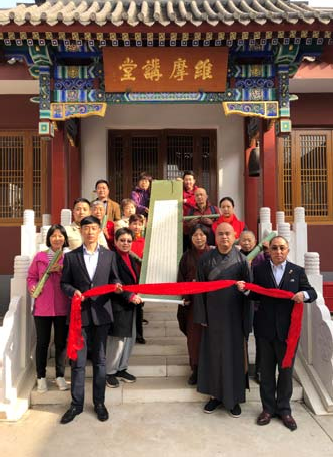
海棠山普安寺一希支持书写的《金刚经》赠送北京佛教居士林
The Diamond Sutra written by Pu'an Temple in Haitang Mountain with the support of Yixi was presented to Buddhist Layman community in Beijing
